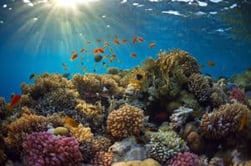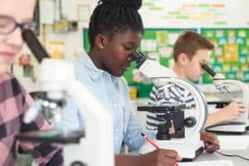Natural Selection Inquiry Lab
Middle School Inquiry Lab on Natural Selection
In this lab students will investigate beak variation in a species of birds. They will understand that populations naturally contain variation of traits and that some variations can either be beneficial or detrimental to the survival of organisms within the population.
Each inquiry lab will contain an essential question that will drive the lesson and make students think. For this lesson, the essential question is:
- How does natural selection cause populations to change over time?
BACKGROUND INFORMATION AND MATERIALS LIST:
Students will begin the lab by reading the essential question and background information. This can be done individually, as lab groups, or as a whole class. If you consider lab groups, you also might include some type of whole class formative checks before digging into the lab.

Materials List:
- plastic spoon
- pair of tweezers
- large binder clip
- 2 wooden skewers
- shoebox lid (or similar tray/container – feeding grounds)
- 4 plastic cups
- large amounts of:
- dried beans
- toothpicks
- dried macaroni
- marbles
PROCEDURE:
This lab is designed to not only to teach students about adaptations but will spark a little competition. Students will select a beak of their choice which they will use to gather as much food as time allows. Students will have to pick up one item at a time. After the time has expired, if students have less than necessary to survive, the student (the bird) has died and is out of the game. If students get more than another given number, not only did they survive, but they are able to reproduce as well.
After every round, students will track the type and amount of food they were able to obtain. This lab helps students to understand that not all beaks can do the job of getting food. Like Darwin discovered, beak shapes are designed for specific food types.
CHECK FOR UNDERSTANDING:
At this point in the lab, students will be checked for understanding by answering questions about their findings. Here are a few that come with the lab:
- Which food do you think will be easiest for your beak to eat and why?
- Which food was the most difficult for your beak to eat and why?
CONCLUSION
Students will go back to the essential question and write a CER (Claim, Evidence, Reasoning) to conclude the lab. Once completed, students will reflect back on their learning by answering the following questions:
- Did any birds survive all rounds? What made them so successful?
- Which beak was least adapted to the food available? What made eating more difficult for them?
- How did your strategy change in the later rounds?
- If your bird left the island and returned 100 years from now, what types of birds do you think would be living on the island?
- Why is variation important for the survival of a species?
MODIFIED AND INDEPENDENT INQUIRY VERSIONS
All of the Kesler Science inquiry labs come with three different modification levels. Each lab is differentiated using the icons below.
STANDARDS ALIGNMENT
TEKS: 7.11C – Identify some changes in genetic traits that have occurred over several generations through natural selection and selective breeding such as the Galapagos medium ground finch (Geospiza fortis) or domestic animals.

Download Over $100 in FREE Resources
For Middle School Science
Simply create a login below and gain immediate access to a selection of our Kesler Science product line worth $100 - for FREE. There's a full version of every product type! You'll also join tens of thousands of middle school science teachers who receive timely tips and strategies straight to their inbox.





